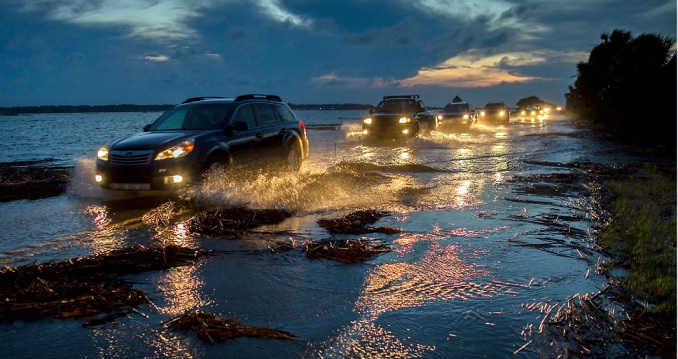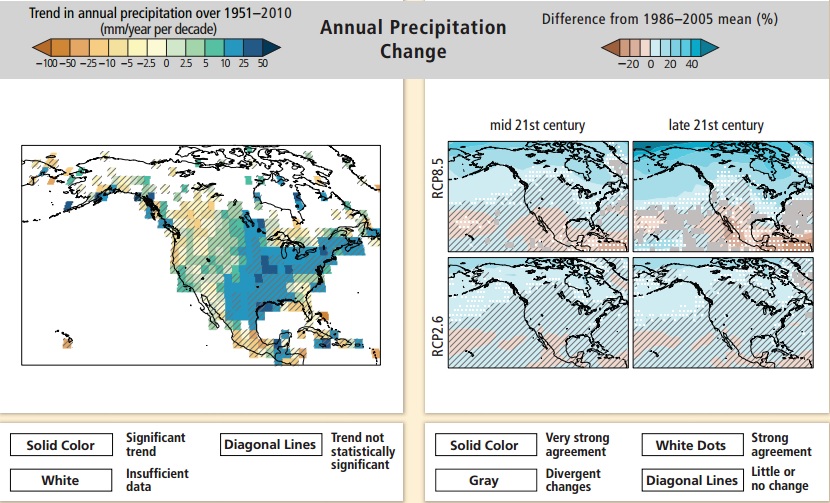When Mitigation Has Failed, Adapt

For many coastal cities, the only choice is adapting to the encroaching seas.
Recall that there are two basic ways we can confront climate change: mitigation and adaptation. Either we can scale back our fossil emissions as close to zero as possible and increase the uptake of CO2 by natural reservoirs (preferably land-based), or we can put in place protections from the inevitable repercussions to come.
It stands to reason that if we cannot cease putting ancient carbonized sunshine into the atmosphere by burning fossil fuels and tearing down forested land, then at some point our efforts will have to prioritize the latter. When the Romans have ransacked all your neighbors, the focus eventually shifts from calculating risk to preparing for the arrival of the new regime. And indeed, status reports indicate we’ve already surpassed a number of tipping points that “lock us in” to certain climate ramifications — sea level rise being the most proximate and palpable.
A new piece, out in The New York Times today, titled Flooding of Coast, Caused by Global Warming, Has Already Begun, shines a light on some of the sea level impacts well underway in major cities up and down the eastern seaboard, and a few of the budding adaptation programs municipalities are leaning on to cope. Boston, New York, Norfolk, Charleston, Savannah, virtually all of South Florida, and various other coastal towns have in recent months and years experienced increased tidal flooding from a gradually encroaching ocean.
Miami-Dade appears to have pioneered one effective solution to stem the coastal woes. According to the Times, an engineering crew comes in, “rips up problematic streets, raises them with extra dirt and repaves them, installing new drains and giant pumps that can push water back into the bay. The approach has already been shown to work in several neighborhoods.” It’s crude and rather brute-forcey, but surely a relief for residents trudging through ankle-deep water on their way to the market.
Norfolk, VA is another showcase city experiencing an uptick in nuisance flooding. Rulers situated along the sides of the road help drivers gauge whether intersections and low-lying streets are safe to navigate at speed. That something more substantial is needed to defend against times of high water has not gone unnoticed. Thanks to activism in the Hampton Roads area and surrounding communities, the state has achieved priority at the federal level, in the form of a $100 million infusion by the Obama administration.
As part of the program, Old Dominion University will serve as pilot with the aim of coordinating efforts between the public and private sectors. Sea walls will need to be reinforced, floodgates installed, sewage plants rebuilt. That federal grant may sound generous, but the sum is state-wide, and pales in comparison to what the city of Norfolk alone has estimated it needs — $1.2 billion — which, the Times notes, translates to $5,000 for each of the 250,000 Norfolk residents.
Other parts of the country are taking different approaches, many of which the Times story neglects to mention. To combat flooding of the sewer system following storm surges, New York City is capturing rainwater using green technology and elevating at-risk equipment. Hydroelectric facilities, such as the 540-foot tall Ross Dam in Washington, are being lifted up to address local vulnerability. South Florida municipalities are currently assessing what is known as forward pumping, an innovative technique which increases groundwater discharge to the ocean, among other flood protection measures.
Too Little, Too Late?
These response efforts look promising and are absolutely necessary, but are they much more than patch treatments buying us time that should have been spent coordinating a national climate policy decades ago? Even if coastal initiatives withstand proof of concept, this assumes sufficient public funding for the massive infrastructural projects they entail. We’ve long known of the risks rapid changes in the climate pose and their associated vulnerabilities, and yet we toiled and denied and refrained from enforcing that knowledge as national spokesmen debated the integrity of scientific communities. One can’t help but conclude that chasing mitigation earlier could have lessened much of this burden.
Concerns about ecosystem management, particularly with regard to sea level rise, will continue to mount as climate change takes its course. For perspective, our best evidence indicates that global sea levels rose a little over eight inches between 1880 and 2010. That’s an average of 1.6 mm per year. Meanwhile, according to NASA sea level has risen roughly four inches just since 1993, or 3.4 millimeters per year. In other words, we’ve more than doubled the background trend of sea level rise by contributing more and more heat to the ocean and melting more and more grounded ice.
If we maintain current emissions, IPCC projections point to between half a meter (1.6 feet) and a full meter (3.2 feet) of sea rise by the end of this century. This should be cause for shudder given that such a figure directly endangers the 150 million people currently living within one meter of sea level. And these figures assume a steady rate of ice loss at the poles. Were melting of the Greenland and West Antarctic ice sheets to accelerate or trigger a full-blown collapse, the impacts to seaside communities would be nothing short of catastrophic.
Many coastal cities already have a number of provisions in place for rising tides, and that’s due to the other variable tied into flood management: rainfall. With a warmer atmosphere comes increased moisture aloft — where a 1 C increase in temperature yields a 7% increase in water vapor — and this translates to higher levels of precipitation, especially in coastal regions.
In AR5, the IPCC found strong evidence for increased annual precipitation over the past century for the east coast and Pacific Northwest. Looking ahead, models predict the trend to continue apace, consistent with seasonal floods beginning earlier, and having earlier peaks and longer durations. This makes poorly fortified flood barriers and deficient drainage systems a prime target for institutional strengthening.
With hundreds of naval bases hugging the nation’s coastline, our military have felt these effects firsthand. A recent report by the Union of Concerned Scientists identified the risks and impacts associated with sea level rise for eighteen coastal bases along the East Coast and Gulf of Mexico. Their analysis warns that the land on which several of these bases are built — including the Naval Station in Norfolk, the world’s largest — is at high risk of being lost to the ocean this century if trends continue on their current path.
Military authorities have taken steps to shield their installations from the growing exposure, but have also encountered increasing resistance from Congressional partisans. Republican officials like David McKinley (R-WV) and Ken Buck (R-CO) have each introduced amendments that would limit defense budgets to non-climate related initiatives, which include important directives on boosting climate preparedness at all levels of the military and shoring up vital training and testing grounds and housing for thousands of military personnel stationed on high-risk bases.
But while Congress continues to impede progress on adaptive measures, defense agencies have moved forward. The DOD, a traditionally conservative institution, has factored climate change into their risk assessments and national security operations at least since the Bush era, with Pentagon officials declaring it a “threat multiplier” that has already drastically altered how they carry out war games exercises and other ops in regions such as the Arctic, sub-Saharan Africa and South Asia.
Clearly, mitigation and adaptation are complementary strategies. But as the need for adaptation grows more apparent with each passing year, we can expect entire industries to emerge in this space. The need will be especially acute for regions which the IPCC has identified as having adaptation deficits in terms of overall readiness for climate hazards, to say nothing of fiscal constraints and conservative obstructionism. If we are truly to build more resilient societies that can weather the changes ahead of us, it will take a great deal more than good ideas and good science. It requires communities and stakeholders at every level of society working together to drive forward viable solutions for global benefit.
“For decades, as the global warming created by human emissions caused land ice to melt and ocean water to expand, scientists warned that the accelerating rise of the sea would eventually imperil the United States’ coastline. Now, those warnings are no longer theoretical: The inundation of the coast has begun. The sea has crept up to the point that a high tide and a brisk wind are all it takes to send water pouring into streets and homes.”
Read more at The New York Times.
Further reading:
- Flooding of Coast, Caused by Global Warming, Has Already Begun
- Climate Central: Sea Level Rise
- Grappling with Sea Level Rise Sooner and Not Later
- Greenland Is Melting Away
- Sea Level Rise Is On the Up and Up
Feature image credit: The New York Times



Comments